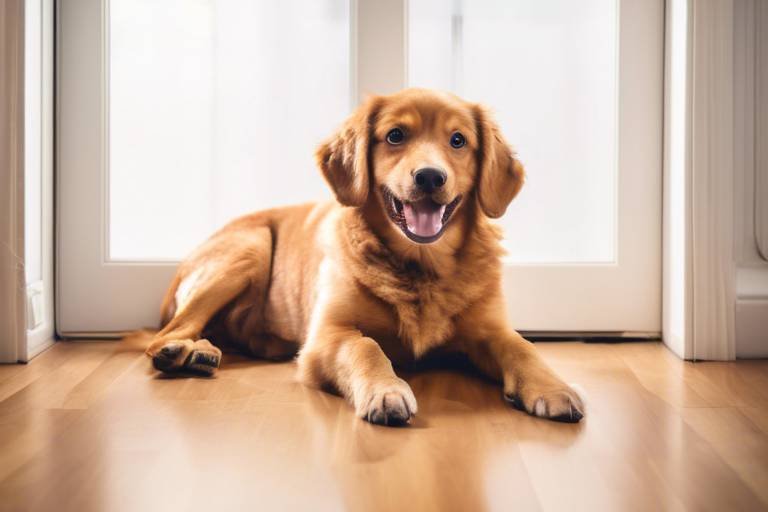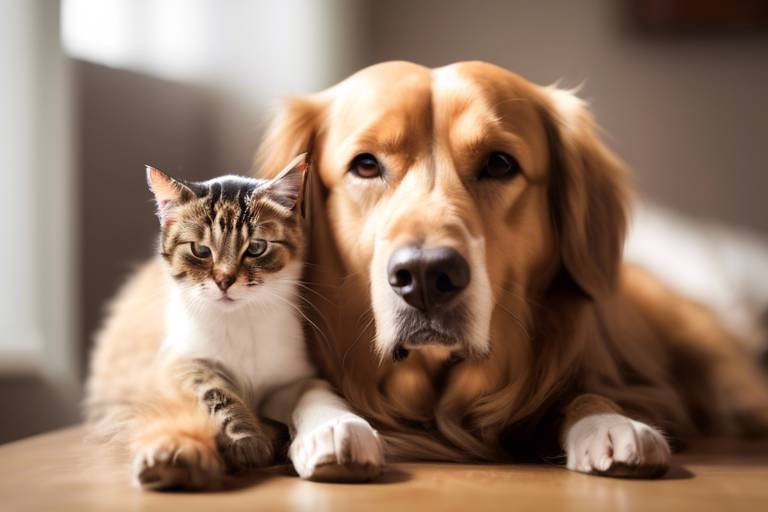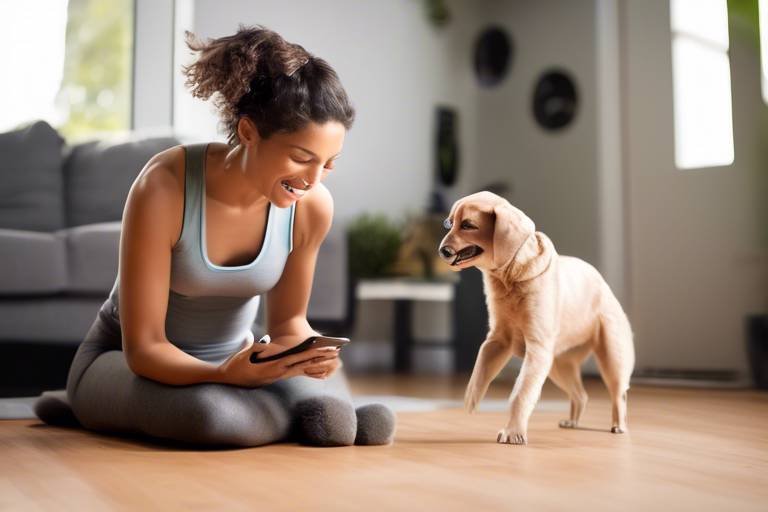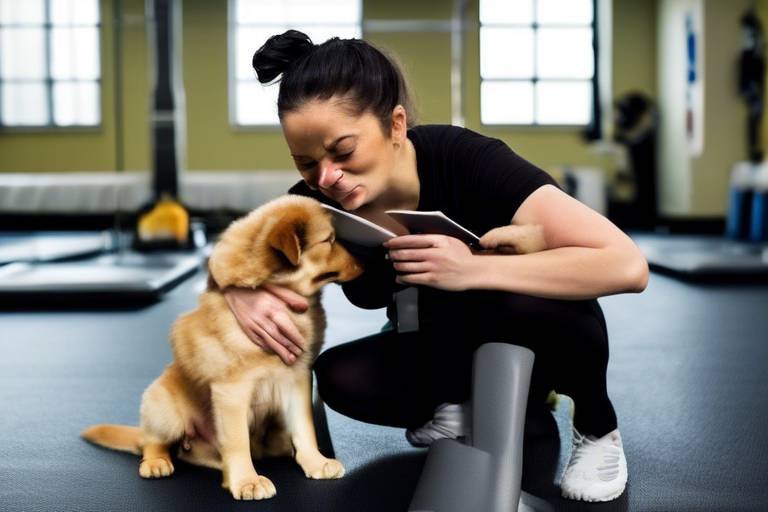How to Help Your Dog Cope With Change in the Home
Change is a constant in life, and while we humans might embrace it with open arms, our furry friends often view it with a mixture of confusion and anxiety. Whether it’s moving to a new house, welcoming a new family member, or even just rearranging the furniture, these transitions can be stressful for dogs. So, how can we, as loving pet owners, help our dogs navigate these changes smoothly? The key lies in understanding their needs and providing them with the right support. In this article, we’ll explore effective strategies to ensure your dog remains comfortable and emotionally secure during times of transition.
Before we dive into solutions, it's essential to recognize the signs of anxiety in our canine companions. Dogs communicate their discomfort in various ways, and being attuned to these signals can make all the difference. Common behaviors that indicate your dog may be struggling with changes include:
- Excessive barking or whining: If your dog suddenly becomes vocal, it might be their way of expressing distress.
- Destructive behavior: Chewing furniture or digging can be a sign of stress.
- Avoidance or hiding: If your pup retreats to a corner or under the bed, they may be feeling overwhelmed.
- Changes in appetite: A sudden loss of interest in food can indicate anxiety.
Being aware of these signs allows you to take proactive steps to ease their anxiety and create a supportive environment.
One of the most effective ways to help your dog cope with change is to establish a designated safe area in your home. This sanctuary can provide them with a sense of security and comfort during tumultuous times. But how do you create the perfect safe space? Let’s break it down:
The location of your dog's safe space is crucial. Ideally, it should be a quiet area away from the hustle and bustle of daily life. Consider places like a cozy corner in the living room or a separate room where your dog can feel secure. You want to select a spot that minimizes stress and maximizes security for your furry friend. Think of it as their personal retreat, a place where they can escape the noise and chaos of the world.
Once you've chosen the location, it’s time to personalize the space. Incorporate your dog's favorite toys, blankets, and even a piece of your clothing. Familiar items can significantly enhance their safe space, helping to soothe anxiety and promote relaxation. Imagine how comforting it is for them to snuggle up with a blanket that smells like you! This connection can provide a sense of normalcy amidst the changes.
Consistency is key when it comes to your dog's safe space. Even as changes occur in your home, strive to keep this area stable. Avoid moving their belongings around or altering their environment too frequently. This stability can help your dog feel secure, knowing that they have a reliable spot to retreat to when things get overwhelming.
Dogs thrive on routine, and maintaining a regular schedule can help alleviate anxiety. Consistent feeding, walking, and playtimes provide a sense of stability for your dog. Just like us, dogs find comfort in predictability. Imagine how unsettling it would be if your daily routine suddenly changed—your dog feels the same way! By keeping their schedule intact, you can help them feel more secure and less anxious about the changes around them.
When it comes to introducing changes, gradual transitions are essential. Jumping into a new situation too quickly can overwhelm your dog. Instead, take baby steps. For instance, if you’re moving to a new home, start by allowing your dog to explore the new surroundings at their own pace. This gentle introduction can help them adjust without feeling pressured. Think of it as dipping your toes into a pool before diving in—it's all about easing into the experience.
Positive reinforcement can be a game-changer when it comes to helping your dog adapt to change. Rewarding your dog for exhibiting calm behavior or exploring new environments can encourage confidence and reduce anxiety. Treats, praise, and affection are all excellent ways to reinforce positive behavior. Imagine how great it feels when someone acknowledges your efforts—your dog feels the same way! This encouragement can motivate them to embrace change rather than shy away from it.
Lastly, it’s crucial to keep an eye on your dog's behavior during transitions. Being vigilant allows you to identify signs of stress early on and intervene when necessary. If you notice your dog becoming anxious or agitated, don’t hesitate to offer comfort or redirect their focus. Just like a caring friend would do, your support can help them navigate through the changes with greater ease.
1. How can I tell if my dog is anxious?
Look for signs such as excessive barking, destructive behavior, avoidance, and changes in appetite.
2. What should I include in my dog's safe space?
Incorporate their favorite toys, blankets, and items that carry your scent to create a comforting environment.
3. How long does it take for a dog to adjust to change?
Every dog is different, but with patience and support, most dogs can adjust to changes within a few weeks.
4. Is it okay to use calming products for my dog?
Yes, calming products such as pheromone diffusers or anxiety wraps can be helpful, but consult your vet for recommendations.
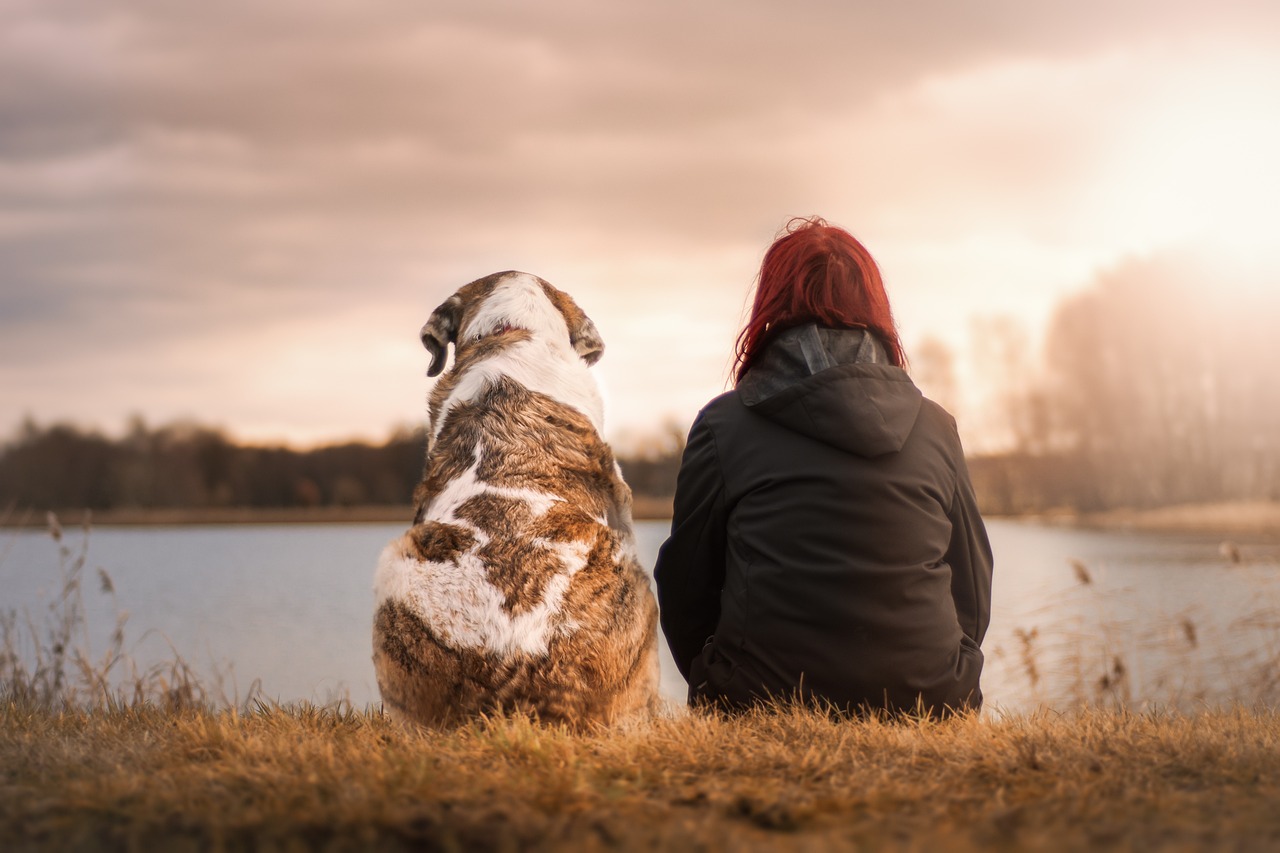
Understanding Canine Anxiety
Recognizing the signs of anxiety in dogs is crucial for ensuring their well-being, especially during times of change in the home. Just like humans, dogs can experience stress and anxiety, which can manifest in various behaviors. Have you ever noticed your furry friend acting differently when there’s a shift in their environment? It’s essential to be aware of these signs, as they can help you understand what your dog is feeling and how best to support them.
Common behaviors that indicate your dog may be struggling with changes in their environment include:
- Excessive barking: If your dog seems to bark more than usual, it could be a sign of stress.
- Destructive behavior: Chewing on furniture or other items can indicate anxiety.
- Hiding: Dogs that retreat to corners or under furniture may be trying to cope with overwhelming feelings.
- Changes in appetite: A sudden disinterest in food or overeating can be a response to anxiety.
- Pacing: If your dog is unable to settle down and is constantly moving around, it may be a sign of discomfort.
Understanding these behaviors is the first step in helping your dog cope with changes. Just think of your dog as a little emotional sponge, soaking up everything happening around them. When a new baby arrives, a family member moves out, or even when you rearrange the furniture, your dog can feel the shift in the atmosphere. They might not understand what’s happening, but they can sense the change in energy.
Moreover, it’s essential to recognize that each dog is unique. Some may show signs of anxiety more prominently than others, while some may be more resilient to change. Factors such as age, breed, and past experiences can all play a role in how your dog reacts to new situations. For example, a rescue dog with a history of instability may be more sensitive to changes than a dog that has always had a stable home. Understanding your dog's individual needs and behaviors will empower you to provide the support they need.
In conclusion, being attentive to your dog's behavior during transitions is key. By recognizing the signs of anxiety and understanding what they mean, you can take proactive steps to help your dog feel more secure and comfortable in their environment. Remember, a calm and happy dog is a reflection of a supportive home, so let’s ensure we create that atmosphere, especially during times of change!
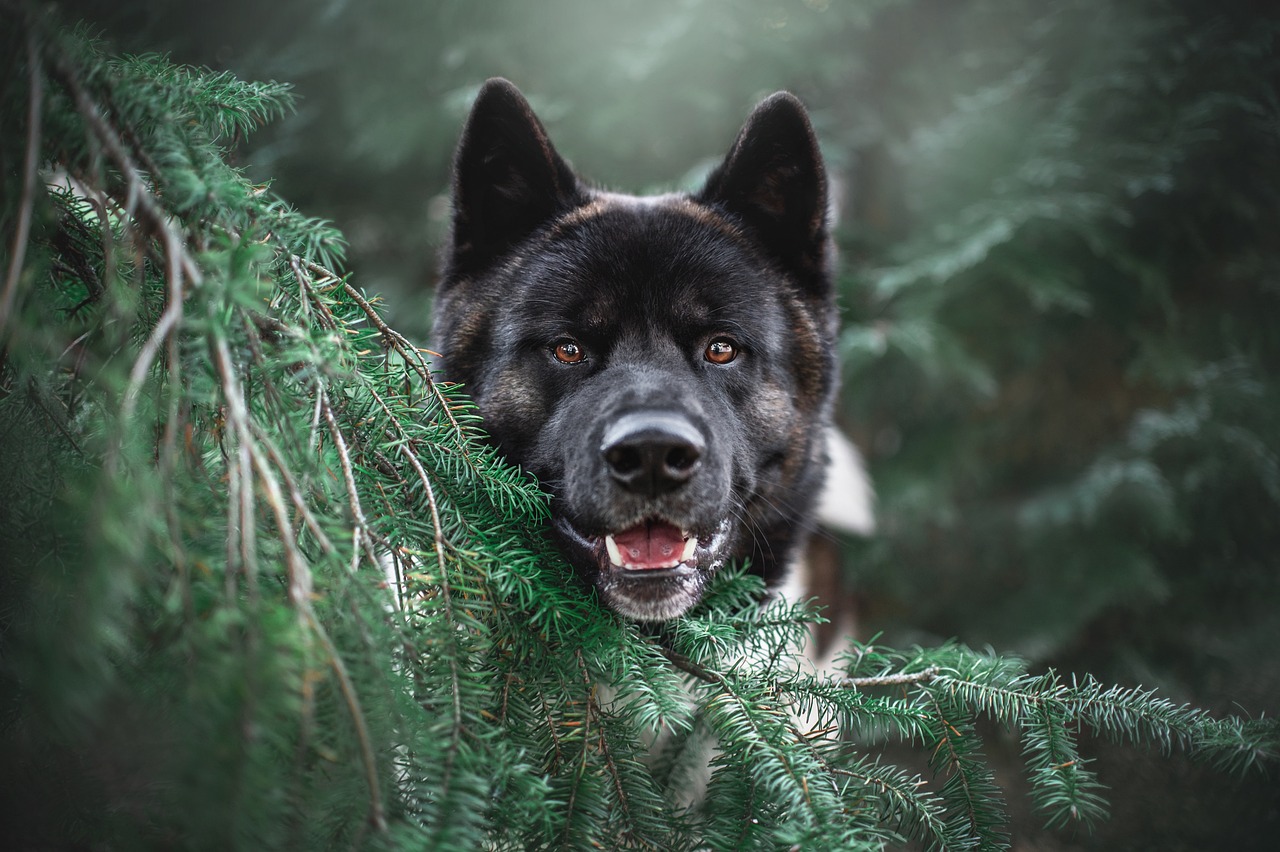
Creating a Safe Space
When life throws changes at us, it can feel like a whirlwind—especially for our furry companions. Dogs, much like us, thrive on stability and routine. Creating a safe space for your dog is not just a luxury; it’s a necessity during times of transition. This cozy nook can serve as a sanctuary where your dog can retreat, feel secure, and process the changes happening around them. Imagine it as their own little fortress, a place where they can escape the chaos and find solace.
To craft this haven, start by selecting a location that feels secure and quiet. Dogs often gravitate towards areas that are away from heavy foot traffic, loud noises, and bright lights. The perfect spot could be a corner of a room, a cozy nook under a staircase, or even a designated area in your bedroom. The key is to choose a location that minimizes stress and maximizes comfort. Think of it as setting up a camping site in the wild—your dog needs a place where they can feel safe from the 'wild' of everyday life.
When choosing the right location for your dog’s safe space, consider the following factors:
- Noise Level: Avoid areas near loud appliances, busy streets, or other sources of noise that may trigger anxiety.
- Access to Natural Light: Dogs enjoy a bit of sunlight! A spot with natural light can help uplift their mood.
- Proximity to Family: While they need their own space, being close to family can provide comfort. Make sure they can still feel your presence.
Once you’ve chosen the perfect spot, it’s time to make it feel like home. Incorporating familiar items into their safe space can work wonders. Dogs are creatures of habit, and having their favorite blanket or toy nearby can create a sense of familiarity that eases anxiety. Imagine how comforting it is for you to curl up with your favorite pillow after a long day—your dog feels the same way! These items can act as emotional anchors, providing a sense of security.
Consider adding the following items to your dog’s safe space:
- Favorite Toys: Toys that your dog loves can provide comfort and distraction.
- Blankets: A soft blanket that smells like home can be incredibly soothing.
- Clothing: An old t-shirt or piece of your clothing can carry your scent, which can be very reassuring for your dog.
Another crucial aspect of creating a safe space is maintaining consistency. Dogs are sensitive to changes in their environment, and having a stable area can help them feel grounded. Even during periods of change, try to keep their safe space intact. This means keeping their bed, toys, and other items in the same place. Think of it as a lighthouse in a storm; it remains constant, guiding them safely through the rough waters of change.
Consistency in your dog's safe space can be achieved by:
- Regular Cleaning: Keep the area clean and free from clutter to maintain a calming environment.
- Routine Checks: Ensure their favorite items are always available and in good condition.
- Limit Changes: Avoid moving their safe space around frequently; stability is key.
By establishing a safe space filled with familiar items and maintaining consistency, you’re providing your dog with a much-needed refuge during times of change. This sanctuary will not only help them cope with anxiety but will also strengthen the bond you share. Remember, your dog looks to you for guidance and comfort, so creating a cozy corner just for them is one of the best gifts you can give during turbulent times.
Choosing the Right Location
When it comes to creating a safe space for your dog, the location you choose is absolutely crucial. Think of it as picking the perfect spot for a cozy hideaway; it needs to be somewhere that makes your furry friend feel secure and at ease. Ideally, this space should be away from the hustle and bustle of daily life, allowing your dog to retreat from any overwhelming stimuli, such as loud noises or lots of foot traffic. A quiet corner of your home, perhaps in a bedroom or a less-trafficked area of the living room, can serve as an ideal sanctuary.
Moreover, consider the temperature and lighting of the chosen area. Dogs, like humans, can be sensitive to their environment. A spot that is too hot or too cold can add to their discomfort during stressful times. Natural light is great, but too much can be overwhelming, so aim for a balance that keeps the area bright yet soothing. If you're unsure, try observing your dog’s behavior in different areas of your home. Do they gravitate towards certain rooms or corners? These preferences can provide valuable clues about where they feel most comfortable.
Another important aspect is accessibility. Your dog should be able to reach their safe space easily, especially during times of anxiety. If they have to navigate obstacles or travel far, it might deter them from using it when they need it most. Consider placing their safe area near where they usually spend time or where you often are. This way, they can feel your presence even when they need a moment alone.
Finally, think about the noise levels. If your home is often filled with sounds like vacuuming, construction noise, or even the chatter of family members, it can be disconcerting for your dog. A room with thick walls or a heavy door can help muffle these sounds, creating a more peaceful environment. You might even consider using white noise machines or calming music to further drown out any disruptive noises, making the space even more inviting.
In summary, the right location for your dog's safe space should be:
- Quiet: Away from high-traffic areas and loud noises.
- Comfortable: Maintain a pleasant temperature and adequate lighting.
- Accessible: Easy for your dog to reach without obstacles.
- Secure: A place where they can feel safe and protected.
By taking these factors into account, you can create a safe haven that helps your dog cope with changes in their environment, ultimately leading to a happier and more relaxed pet.
Incorporating Familiar Items
When it comes to helping your dog cope with change, one of the most effective strategies is into their safe space. Just like how we find comfort in our favorite blanket or a cherished photograph during tough times, dogs too feel more secure when surrounded by things they recognize and love. By providing these familiar items, you're not just decorating their space; you're creating a sanctuary that resonates with their past experiences and comforts them during transitions.
Start by gathering your dog's favorite toys, blankets, and any other items that carry their scent or have been part of their daily life. For example, if your dog has a beloved stuffed animal that they snuggle with, make sure it’s included in their safe area. The presence of these items can significantly reduce feelings of anxiety and promote relaxation. In fact, studies have shown that familiar scents can trigger positive memories and feelings of safety in dogs, which is incredibly beneficial during periods of change.
Moreover, consider the emotional weight these items carry. A well-loved blanket might remind your dog of cozy nights spent together, while a favorite chew toy could evoke memories of playful afternoons. Each item serves as a tangible connection to their past, providing reassurance that even though things are changing, some aspects of their life remain constant. It’s like having a piece of home with them, no matter where they are.
Additionally, you can rotate their familiar items to keep the environment fresh while still maintaining that comforting essence. For instance, if your dog has several toys, you can periodically switch them out to keep their space engaging without losing the familiar feel. This method not only keeps your dog entertained but also helps them adjust to changes in their surroundings more smoothly.
In summary, incorporating familiar items into your dog's safe space is a simple yet powerful way to enhance their emotional well-being during transitions. By surrounding them with things they love and recognize, you’re providing them with a sense of stability and comfort. It’s a small gesture that can make a world of difference in how they cope with changes in their environment.
- What types of familiar items should I include in my dog's safe space?
Include toys, blankets, and anything that carries your dog's scent or has been part of their daily life. Familiar items can help soothe anxiety.
- How can I tell if my dog is feeling anxious about changes?
Signs of anxiety in dogs can include excessive barking, pacing, hiding, or changes in eating habits. Monitoring their behavior can help you identify when they are stressed.
- Is it okay to introduce new items into my dog's safe space?
Yes, but make sure to introduce them gradually. New items can be mixed in with familiar ones to keep the environment engaging while still providing comfort.
- How long should I keep familiar items in their safe space?
As long as your dog finds comfort in them! You can rotate items to keep their space fresh, but always ensure they have access to at least a few familiar items.
Maintaining Consistency
When it comes to helping your dog cope with change, consistency is key. Dogs thrive on routine; it's like a comforting blanket that wraps around them, providing security and predictability. Imagine how you feel when your daily schedule is thrown into chaos—it's disorienting, right? Well, your furry friend feels that too. Maintaining a consistent environment can significantly reduce anxiety and help your dog adjust to changes more smoothly.
To achieve this consistency, consider the following aspects:
- Feeding Schedule: Keep feeding times the same every day. This helps your dog know what to expect and when, which can be incredibly reassuring.
- Walks and Exercise: Try to stick to a regular walking schedule. Regular exercise not only helps your dog physically but also mentally, as it gives them something to look forward to.
- Playtime and Interaction: Make sure to dedicate time each day for play and bonding. This reinforces your connection and provides comfort amidst the changes.
It's also essential to maintain the same rules and boundaries. If your dog is used to being allowed on the couch, but suddenly you decide to change that rule during a stressful time, it might confuse them and increase their anxiety. Instead, try to keep the same rules in place, even if the circumstances around them are changing.
Additionally, consider the physical environment. If you're moving furniture around or changing the layout of your home, try to keep your dog's space the same. This way, they have a familiar spot to retreat to, which can help ground them during transitions. Think of it as their little haven amidst the storm of change.
In summary, in your dog's routine and environment can significantly ease their anxiety during times of change. By keeping feeding times, exercise routines, and household rules stable, you create a sense of security that helps your dog navigate through life’s inevitable transitions with confidence and calm.
Q1: How long does it take for a dog to adjust to change?
A1: The adjustment period varies by dog. Some may adapt within a few days, while others may take weeks or even months. Patience and consistency are essential.
Q2: What signs should I look for to know my dog is stressed?
A2: Common signs of stress include excessive barking, panting, pacing, hiding, or changes in appetite. If you notice these behaviors, it may be time to intervene.
Q3: Can I use calming products to help my dog?
A3: Yes! There are various calming products available, such as pheromone diffusers, anxiety wraps, and calming treats. Always consult your vet before introducing new products.
Q4: Is it okay to change my dog's routine during a transition?
A4: It's best to keep their routine as consistent as possible during transitions. If changes are necessary, introduce them gradually to minimize stress.
Routine and Structure
When it comes to helping your dog cope with change, establishing a solid routine is like laying down a welcome mat for their emotional well-being. Dogs thrive on predictability; it's their comfort zone. Just think about it: if you were suddenly thrown into a new environment without any idea of what to expect, wouldn’t you feel a bit lost? For our furry friends, a consistent routine provides a sense of security and normalcy, especially during turbulent times.
Imagine starting each day with the same sequence of events. Your dog wakes up, and the first thing they anticipate is a morning walk, followed by breakfast at the same time every day. This predictable schedule not only helps them feel grounded but also reduces anxiety. By maintaining regular feeding, walking, and playtimes, you’re essentially creating a roadmap for their day, guiding them through the changes with ease.
To create a routine that works for both you and your dog, consider the following key components:
- Feeding Times: Stick to a consistent feeding schedule. This helps your dog know when to expect their meals, reducing anxiety around food.
- Exercise: Regular walks and play sessions should be at the same time each day. This not only keeps them physically healthy but also mentally stimulated.
- Quiet Time: Designate periods for rest. Dogs need downtime just like we do, and this can be especially important during transitions.
Moreover, incorporating these elements into your dog's daily life can help them adapt to changes more smoothly. Think of it as building a sturdy bridge over a river of uncertainty. If they know what to expect, they are less likely to panic when faced with new situations, such as moving to a new home or welcoming a new family member.
Also, don't underestimate the power of visual cues. You might want to use a calendar or a chart to mark daily routines, which can be especially useful during transitions. For instance, if you’re moving, you can mark the days leading up to the move and include notes about what your dog can expect during that time. This visual representation can help both you and your pup stay on track and feel more secure.
In conclusion, a well-structured routine is not just about keeping your dog busy; it's about providing them with a sense of stability and comfort. By establishing a predictable daily schedule, you’re not only helping your dog navigate through changes but also strengthening your bond with them. Remember, a happy dog is a well-structured dog!
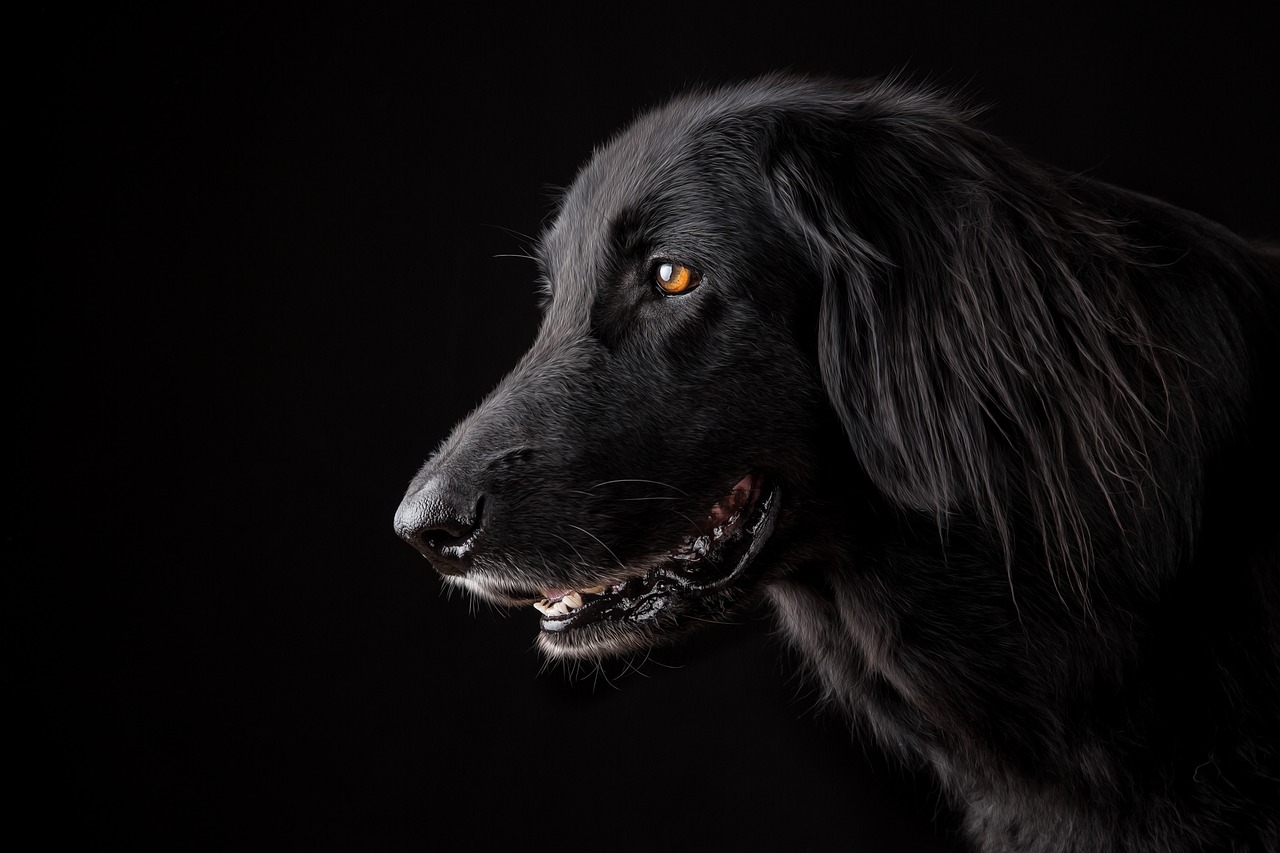
Gradual Introductions to Change
When it comes to helping your dog navigate through changes in the home, one of the most effective strategies is to introduce these changes gradually. Think of it like easing into a chilly pool on a hot day; you wouldn't just dive in without acclimating, right? Similarly, your furry friend will benefit from a gentle approach when faced with new situations or environments. By taking things slow, you can help your dog feel more secure and less overwhelmed.
Start by identifying the specific changes that are on the horizon. Whether it’s a new family member moving in, a change in your work schedule, or even a simple rearrangement of furniture, each of these shifts can be a source of anxiety for your pup. Once you pinpoint these changes, break them down into smaller, manageable steps. For example, if you’re bringing a new baby home, allow your dog to get used to the sounds of baby toys or the scent of baby lotion before the actual arrival. This way, they can associate these new experiences with positive feelings rather than anxiety.
Another effective technique is to incorporate positive reinforcement during these gradual introductions. When your dog shows curiosity or calmness towards the new changes, reward them with treats or praise. This not only encourages them to explore their new environment but also builds their confidence. Imagine how much more comfortable you’d feel in a new situation if someone was cheering you on! The same principle applies to your dog.
Moreover, it’s essential to monitor your dog’s reactions throughout the process. Each dog is unique, and their responses to change can vary widely. Keep an eye out for signs of stress, such as excessive barking, hiding, or changes in eating habits. If you notice these behaviors, it may be a signal to slow down the introduction process. After all, the goal is to ensure your dog feels secure and supported during these transitions.
To help you visualize this gradual approach, here’s a simple table outlining steps you can take for various changes:
| Change | Gradual Introduction Steps |
|---|---|
| New Family Member |
|
| Moving to a New Home |
|
| Change in Routine |
|
In summary, gradual introductions to change can significantly ease your dog's anxiety and help them adapt more comfortably to new situations. By taking a step-by-step approach, using positive reinforcement, and keeping a close watch on their behavior, you can transform what could be a stressful experience into a manageable one. After all, your dog relies on you to be their guide, and with a little patience and understanding, you can help them thrive even in times of change.
Q1: How long should I take to introduce changes to my dog?
A1: The duration can vary based on the change and your dog's temperament. Generally, take a few days to weeks, depending on how your dog is reacting.
Q2: What if my dog shows signs of extreme anxiety?
A2: If your dog exhibits severe anxiety, consider consulting a veterinarian or a professional dog trainer for tailored advice and potential behavioral therapy.
Q3: Can I use calming products to help my dog during transitions?
A3: Yes! Calming products like pheromone diffusers, anxiety wraps, or calming treats can be beneficial in easing your dog's stress during changes.
Using Positive Reinforcement
When it comes to helping your dog cope with changes in their environment, positive reinforcement can be a game changer. Think of it as a way to reward your furry friend for exhibiting calm behavior during stressful times. Just like how we feel more confident when someone praises us for a job well done, dogs thrive on encouragement and rewards. By using treats, praise, or playtime as incentives, you can create a supportive atmosphere that encourages your dog to embrace change rather than fear it.
Imagine your dog is experiencing a significant change, like moving to a new home or welcoming a new family member. Instead of letting anxiety take over, you can proactively use positive reinforcement to help them adjust. For instance, when your dog shows curiosity about their new surroundings, shower them with praise and a tasty treat. This not only makes them feel good but also associates the change with positive experiences. Over time, they will start to recognize that change can be a good thing!
Here are some effective ways to implement positive reinforcement during transitions:
- Be Consistent: Consistency is key. Use the same rewards and phrases each time your dog responds positively to a change. This helps them understand what behaviors are desirable.
- Timing is Everything: Reward your dog immediately after they display calm behavior. This helps them connect the dots between their actions and your praise.
- Vary the Rewards: Keep it interesting! Use a mix of treats, toys, and affection to keep your dog engaged and motivated. Just like us, dogs can get bored with the same rewards.
It's also essential to monitor your dog's reactions closely. If you notice signs of stress, such as excessive barking or hiding, it might be time to dial back the changes and focus more on reassuring them. Remember, the goal is to help them build confidence, not overwhelm them. By rewarding small victories as they adapt, you'll be fostering a resilient and happy companion.
Incorporating positive reinforcement into your dog's routine during times of change can create a strong bond between you and your pet. You'll not only be helping them navigate their feelings but also teaching them that you are a source of support. So, the next time your dog faces a transition, remember to celebrate their successes, no matter how small they may seem. After all, every wag of the tail is a step towards a more confident and happy pup!
Q: How long does it take for a dog to adjust to changes?
A: It varies by dog, but with consistent positive reinforcement, many dogs can start to adjust within a few weeks. Patience is key!
Q: What if my dog doesn't respond to positive reinforcement?
A: Every dog is unique. If treats or praise don’t seem effective, try different rewards or consult a professional trainer for personalized strategies.
Q: Can positive reinforcement help with other behavioral issues?
A: Absolutely! Positive reinforcement is an effective training method for various issues, including aggression, fear, and obedience.
Monitoring Their Behavior
When it comes to helping your dog cope with changes in their environment, is absolutely crucial. Just like humans, dogs can express their feelings and discomfort in various ways, and being attuned to these signals can make all the difference. Have you ever noticed your furry friend acting a bit off? Maybe they’re hiding under the bed or barking more than usual? These behaviors can be indicators of stress or anxiety. By paying close attention, you can catch these signs early and take steps to help your dog feel more secure.
Some common behaviors to watch for include:
- Excessive barking or whining: If your dog starts vocalizing more than normal, it might be their way of expressing distress.
- Avoidance or hiding: Dogs may seek out secluded spots when they feel overwhelmed. If your pup suddenly prefers the corner of the room, it’s time to check in.
- Destructive behavior: Chewing on furniture or digging can be signs of anxiety. If your dog is acting out, it’s likely they’re feeling uneasy.
- Changes in appetite: A dog that suddenly refuses to eat or is excessively hungry might be dealing with emotional turmoil.
Keeping a close eye on these behaviors will help you gauge how your dog is handling the changes. But don’t just stop at observation; it’s also important to intervene appropriately. If you notice signs of stress, consider creating a calming environment or using positive reinforcement to encourage them. For example, if your dog seems anxious during a move, try to distract them with their favorite toy or engage them in a fun game. This can help redirect their focus and ease their anxiety.
Additionally, keeping a diary of your dog's behavior can be beneficial. Note when changes occur and how your dog reacts. This record can help you identify patterns and triggers, making it easier to manage their anxiety in the future. If you find that your dog’s behavior is consistently concerning, don’t hesitate to consult with a veterinarian or a professional dog trainer. They can provide valuable insights and strategies tailored to your dog’s specific needs.
Ultimately, your goal is to create a safe and supportive environment for your dog. By monitoring their behavior and responding to their needs, you can help them navigate through changes with more confidence and less stress. Remember, your furry friend relies on you to be their advocate, so keep your eyes peeled and your heart open!
- How can I tell if my dog is anxious?
Look for signs such as excessive barking, hiding, or changes in appetite. Each dog may express anxiety differently. - What should I do if my dog is showing signs of anxiety?
Provide a safe space, maintain a consistent routine, and consider consulting a professional if needed. - Can training help with my dog's anxiety?
Yes! Positive reinforcement training can help build your dog's confidence and ease their anxiety during transitions.
Frequently Asked Questions
-
What are the signs that my dog is experiencing anxiety due to changes at home?
Dogs can be pretty expressive, and their behavior often tells us when they’re feeling anxious. Look out for signs like excessive barking, chewing on furniture, hiding, or even changes in their eating habits. If your furry friend seems restless or overly clingy, it’s a good indication that they might be struggling with the changes around them.
-
How can I create a safe space for my dog?
Creating a safe space for your dog is all about comfort and familiarity. Choose a quiet corner of your home where they can retreat when things get overwhelming. Add their favorite blanket, toys, or even a piece of your clothing to make it feel more secure. The goal is to make it a cozy retreat where they can relax and feel safe.
-
Is it important to maintain a routine for my dog during transitions?
Absolutely! Dogs thrive on routine. Keeping feeding, walking, and playtimes consistent can help provide a sense of stability amidst the chaos of change. Think of it like a comforting anchor in a stormy sea; it helps them feel grounded and secure.
-
What is the best way to introduce changes to my dog?
Gradual introductions are key! Instead of throwing your dog into a completely new situation, take baby steps. For example, if you're moving, you might start by letting them explore one room at a time. This way, they can adjust without feeling overwhelmed. It's all about making the transition as smooth as possible.
-
How can positive reinforcement help my dog cope with changes?
Positive reinforcement is a fantastic way to encourage your dog during tough times. When they show signs of adapting well to a new situation, reward them with treats or praise. This not only boosts their confidence but also helps them associate the change with something positive, making it easier for them to adjust.
-
When should I be concerned about my dog's behavior during changes?
If you notice your dog exhibiting extreme signs of stress, such as persistent hiding, aggression, or loss of appetite, it’s time to take action. Monitor their behavior closely and consult with a vet or a professional dog trainer if needed. Your pup's well-being is the priority!

